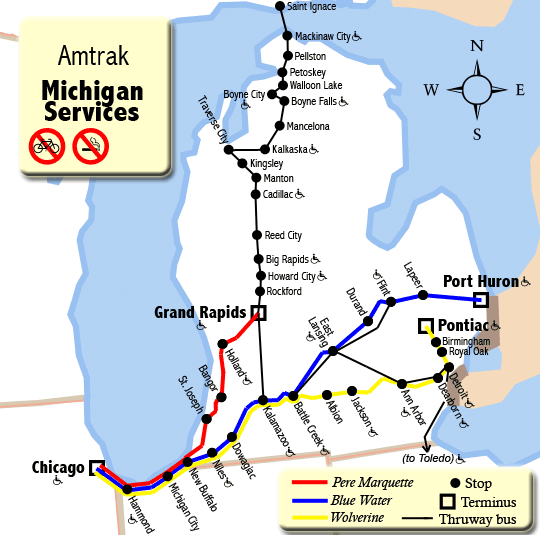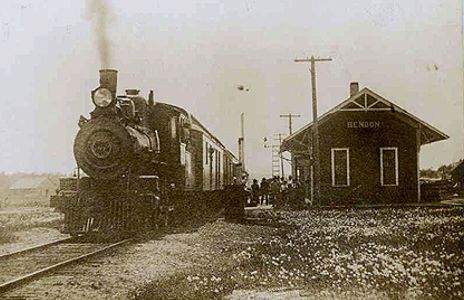By Matthew Varcak
Michigan is seemingly divided into two unequal sections, and that doesn’t just mean the Upper and Lower Peninsulas. When it comes to passenger rail service, the bottom half of the Lower Peninsula is serviced by three major corridors, while the rest of the state has none.
But plans are in the works for passenger rail service to reach one northern tourist destination – Traverse City.
While navigating the southern part of the state is fairly simple with the available trains, buses and taxis, the northern half is virtually inaccessible without a personal vehicle or plane. There are few alternatives besides a once-daily bus which departs from Kalamazoo heading north and includes several stops (namely Traverse City) before ending in Sault Ste. Marie, located on the Canadian border.
The lack of passenger rail to the northern half of Michigan will soon change, as the state looks to expand its light rail service.
“We could possibly have a passenger rail to Traverse City under way in the next five to six years,” said Nick Schirripa, spokesman for the Michigan Department of Transportation. “It may happen sooner.”
Michigan was once a state dominated by railroads. By the start of the 20th century, nearly 8,000 miles of track covered the state. That included one route which ran from Chicago to Traverse City and beyond.
With the rise of the automobile these passenger trains soon disappeared from northern Michigan. By 2010, there were just 4,000 miles of track left.
Freight rail lines to the northern part of the state are still well established, however. A state study evaluating the amount of freight traffic in and out of Traverse City is currently under way and should be completed within a few months, according to the Michigan State Rail Plan project manager Larry Karnes.
“In order to have passenger rail service, you need to have a viable freight network,” Karnes said. But, the current freight rail service to Traverse City operates at a very low speed and is in no condition to provide passenger service.
A study on adding a passenger rail line to the northern Lower Peninsula is coming in the near future, according to Karnes. This would determine the potential cost, ridership and the amount of work needed to upgrade the freight rail lines to accommodate passengers.
“There is nothing necessarily holding back a passenger rail to Traverse City,” Schirripa said. “There is clear ridership potential to Traverse City and beyond. We are just not there yet, but it is on our radar. We are currently focused on the existing passenger rail lines.”
The state of Michigan subsidizes the Amtrak-operated Pere Marquette, Blue Water and Wolverine lines, at a cost of roughly $40 million annually according to Karnes.
Michigan is part of a multi-state effort to improve the approximately 300-mile Detroit-Chicago corridor (Wolverine) to an accelerated rail capable of reaching speeds of up to 110 mph. Once complete, trains will travel at this speed for nearly 80 percent of the distance, reducing travel time by nearly two hours.
More than $400 million in federal and state funding is being invested to improve track and station conditions along the corridor. MDOT purchased the 135-mile segment of railroad between Kalamazoo and Dearborn for $140 million in Oct. 2011.
Improvements were recently completed between Kalamazoo and Battle Creek, and the state is currently working on replacing track on the segment between Jackson and Dearborn. According to Schirripa, the remainder of the corridor should be completed by the end of 2014 or in early 2015.
Yet, those in the northern half of the Lower Peninsula and the Upper Peninsula are left waiting.
“I do hope it moves forward in my lifetime,” said Traverse City Mayor Michael Estes. The city itself has not explored the issue, but pro-rail groups who have name Traverse City as an ideal stop.
Located on the northwest shore of Michigan’s Lower Peninsula, Traverse City is the largest city in northern Michigan with a population of just under 15,000. Known for its National Cherry Festival held each July, the Sleeping Bear Dunes and a growing restaurant industry, Traverse City relies heavily on tourism.
A passenger rail line to Traverse City would allow tourists from the metro Detroit area, who typically have to drive more than four hours, to leave their cars at home. Estes says this would not only remove vehicles from the streets, but would also aid in the city’s efforts to create a more walkable community.
“People are interested in taking rail and exploring getting away from their cars,” Estes said. He also noted that the project could face issues because of the long distance and many jurisdictions it crosses.
Traverse City Commissioner Ross Richardson says he has heard nothing but support for the idea. Richardson says a passenger rail would hopefully attract more tourists from the southern part of the state while at the same time cutting down on automobile traffic.
The good news is that there is existing track. Great Lakes Central Railroad, which owns the freight rail line between Ann Arbor and Traverse City, has also expressed interest in developing a round-trip passenger train between the two cities.
Its president and CEO, Mike Bagwell, says the passenger rail is “pretty cold as a project but is by no means a dead issue. The main problem is obtaining funding for infrastructure, but no one is really offering up the money.”
According to Bagwell, it will be a minimum of five to six years before the project even begins. When completed, the trip would start in Ann Arbor, include stops in Howell, Durand, Owosso, Mount Pleasant, Clare, Cadillac, and finish in Traverse City.
“It is a good, well supported idea, but it is not even out of the pre-planning stages yet.”
Bagwell also said there is a possibility the route could go beyond Traverse City. Neighboring tourist hot spots such as Charlevoix and Harbor Springs could also be potential stops. It is, however, unlikely passenger rail will stretch beyond the bridge into the Upper Peninsula any time soon.
The state of Michigan is focused on improving its passenger rail system before it is expanded. Once the accelerated corridor is complete, efforts will shift towards bringing passenger rail into the northern half of the Lower Peninsula. If all goes according to plan, it may not be long before passenger trains once again make their way through northern Michigan.


